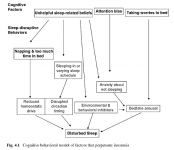David Baxter PhD
Late Founder
Quiet Your Mind & Get to Sleep
Solutions to Insomnia for Those With Depression, Anxiety or Chronic Pain
by Colleen E. Carney and Rachel Manber, New Harbinger, 2009

Reviewed by Beth T. Cholette, Ph.D., Mental Health Net
Sep 7th 2010 (Volume 14, Issue 36)
In this book, authors Colleen Carney and Rachel Manber, both professors as well as directors of sleep disorder programs, describe an approach to insomnia based on cognitive behavioral therapy (CBT). The authors explain that CBT is an effective treatment for addressing a variety of disorders that often co-exist with insomnia, including depression, anxiety, and chronic pain. Given that this book is written in workbook format, with the expectation that the reader will actively participate in the program and complete various exercises, self-tests, and worksheets, Carney and Manber acknowledge that some of their recommendations might seem difficult to follow for certain people, such as those with depression. However, they include specific information on how to overcome any barriers to treatment at the end of the book.
Because the focus of this book is on insomnia which co-exists with depression, anxiety, or chronic pain, Carney and Manber start with an overview of each of these conditions, helping the readers to distinguish the exact nature of their concerns as well as offering ways to determine whether some sleep disorder other than insomnia may be present. Next, the authors provide brief but important information about the sleep system, including the crucial concept of "sleep drive," which is essential to understanding why spending more time in bed can be counter-productive for those with sleep problems. At this point, Carney and Manber begin to introduce specific strategies for improving sleep. They start by reviewing sleep-incompatible behaviors--for example, staying in bed when you can't sleep--and then describing specific techniques to counteract these problematic patterns. They continue to provide action plans for breaking learned habits by addressing topics such as negative beliefs, worry, and relaxation. As the authors discuss each new method, they offer a variety of worksheets which walk the reader through exactly how to use that strategy; similarly, they also share tips for dealing with any obstacles which might arise and provide many case examples to more clearly demonstrate the information provided.
In the last few chapters, Carney and Manber more specifically focus on possible impediments to their treatment program. The first of these is substance and medication use. In this chapter, the authors address how various substances, from caffeine to cigarettes to alcohol to both over-the-counter and prescription medications, affect the quality of sleep. Finally, the authors discuss specific challenges to implementing change. These include issues such as coping with low motivation, feeling overwhelmed, experiencing difficulties concentrating, and additional strategies for dealing with negative thoughts. The book concludes with an Appendix which contains both self-help and web resources not just for sleep but also for depression, anxiety, and chronic pain.
As a psychologist myself, I found this to be an excellent self-help book. Authors Carney and Manber instill a sense of hopefulness, emphasizing the idea that sleep is under one's control and that making small behavioral changes can be immensely beneficial. Although the authors have designed their book specifically for those with co-existing depression, anxiety, or chronic pain, I believe that anyone with insomnia is likely to find this workbook to be extremely useful. I will definitely be recommending Quiet Your Mind & Get to Sleep to the college student clients with whom I work, and I would not hesitate to recommend it to others as well.
Solutions to Insomnia for Those With Depression, Anxiety or Chronic Pain
by Colleen E. Carney and Rachel Manber, New Harbinger, 2009

Reviewed by Beth T. Cholette, Ph.D., Mental Health Net
Sep 7th 2010 (Volume 14, Issue 36)
In this book, authors Colleen Carney and Rachel Manber, both professors as well as directors of sleep disorder programs, describe an approach to insomnia based on cognitive behavioral therapy (CBT). The authors explain that CBT is an effective treatment for addressing a variety of disorders that often co-exist with insomnia, including depression, anxiety, and chronic pain. Given that this book is written in workbook format, with the expectation that the reader will actively participate in the program and complete various exercises, self-tests, and worksheets, Carney and Manber acknowledge that some of their recommendations might seem difficult to follow for certain people, such as those with depression. However, they include specific information on how to overcome any barriers to treatment at the end of the book.
Because the focus of this book is on insomnia which co-exists with depression, anxiety, or chronic pain, Carney and Manber start with an overview of each of these conditions, helping the readers to distinguish the exact nature of their concerns as well as offering ways to determine whether some sleep disorder other than insomnia may be present. Next, the authors provide brief but important information about the sleep system, including the crucial concept of "sleep drive," which is essential to understanding why spending more time in bed can be counter-productive for those with sleep problems. At this point, Carney and Manber begin to introduce specific strategies for improving sleep. They start by reviewing sleep-incompatible behaviors--for example, staying in bed when you can't sleep--and then describing specific techniques to counteract these problematic patterns. They continue to provide action plans for breaking learned habits by addressing topics such as negative beliefs, worry, and relaxation. As the authors discuss each new method, they offer a variety of worksheets which walk the reader through exactly how to use that strategy; similarly, they also share tips for dealing with any obstacles which might arise and provide many case examples to more clearly demonstrate the information provided.
In the last few chapters, Carney and Manber more specifically focus on possible impediments to their treatment program. The first of these is substance and medication use. In this chapter, the authors address how various substances, from caffeine to cigarettes to alcohol to both over-the-counter and prescription medications, affect the quality of sleep. Finally, the authors discuss specific challenges to implementing change. These include issues such as coping with low motivation, feeling overwhelmed, experiencing difficulties concentrating, and additional strategies for dealing with negative thoughts. The book concludes with an Appendix which contains both self-help and web resources not just for sleep but also for depression, anxiety, and chronic pain.
As a psychologist myself, I found this to be an excellent self-help book. Authors Carney and Manber instill a sense of hopefulness, emphasizing the idea that sleep is under one's control and that making small behavioral changes can be immensely beneficial. Although the authors have designed their book specifically for those with co-existing depression, anxiety, or chronic pain, I believe that anyone with insomnia is likely to find this workbook to be extremely useful. I will definitely be recommending Quiet Your Mind & Get to Sleep to the college student clients with whom I work, and I would not hesitate to recommend it to others as well.

